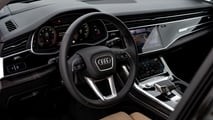The Audi Q7, while not a vehicle designed to turn heads with flashy aesthetics, quietly impresses with its understated elegance and robust performance. The 2025 model, subtly refreshed, continues this tradition, focusing on refining the driving experience and interior comfort rather than dramatic visual changes. For those in the market for a luxury three-row SUV that prioritizes quality and a smooth ride, the Q7 warrants a closer look, especially when considering the array of available upgrades that enhance its already premium feel.
Exterior Elegance: Subtle yet Stylish Design Updates
At first glance, the 2025 Audi Q7 maintains a familiar silhouette, yet a closer inspection reveals thoughtful updates that refine its appearance. The grille has been subtly redesigned, and the light fixtures are refreshed, contributing to a more modern and sophisticated front fascia. While these changes might not be immediately apparent, they collectively contribute to an enhanced visual appeal.
The model tested here further benefits from optional 21-inch five-spoke wheels, a design typically reserved for Audi’s sportier S or RS models. These wheels, combined with the Black Optic package, which introduces Anthracite Gray Audi logos and sleek black accents, and the rich Tamarind Brown metallic paint ($595 extra), create an understated yet undeniably elegant aesthetic. This combination ensures the Q7 projects a premium image without being ostentatious.
 Side view of 2025 Audi Q7 in Tamarind Brown metallic paint showcasing 21-inch five-spoke wheels and Black Optic package.
Side view of 2025 Audi Q7 in Tamarind Brown metallic paint showcasing 21-inch five-spoke wheels and Black Optic package.
Interior Comfort and Technology: A Premium Cabin Experience
Stepping inside the 2025 Audi Q7 is an exercise in understated luxury. The cabin is meticulously crafted with high-quality materials, including supple leather, genuine aluminum, rich wood trim, and durable black plastics. While some glossy surfaces are present, potentially prone to fingerprints, they are used sparingly. The overall impression is one of refined quality, aligning well with the vehicle’s near-$90,000 as-tested price.
The technology interface is anchored by a familiar dual-screen setup: a primary 10.1-inch touchscreen for infotainment and an 8.6-inch lower screen dedicated to climate control and vehicle settings. These screens, carried over from the previous year, function adequately. Audi’s haptic feedback system adds a tactile dimension to the touch controls, making them more user-friendly than some purely touch-based systems. However, the sheer volume of information presented on the screens and a somewhat cluttered layout can occasionally complicate operation, particularly while driving. Notably, the Q7 still lacks certain contemporary tech features, such as a “Hey, Audi” voice assistant and over-the-air software updates, which are increasingly common in this segment.
Fortunately, the 12.3-inch digital instrument cluster, a signature Audi feature, is highly customizable and feature-rich. It effectively places essential information directly in the driver’s line of sight, minimizing the need to interact with the central touchscreens while on the move. Additionally, the steering wheel is equipped with a comprehensive array of controls, providing quick access to frequently used functions.
 Audi Q7 interior showcasing the 12.3-inch digital instrument cluster and dual touchscreen setup.
Audi Q7 interior showcasing the 12.3-inch digital instrument cluster and dual touchscreen setup.
Performance and Driving Dynamics: Smooth Ride, Adequate Power
The 2025 Audi Q7 offers a choice of engines. The base Q7 45 model features a turbocharged 2.0-liter four-cylinder engine producing 261 horsepower and 273 pound-feet of torque. While capable, the reviewed Q7 55 model boasts a more potent turbocharged 3.0-liter V6, delivering 335 horsepower and 369 pound-feet of torque. This V6 enables a 0-60 mph acceleration time of 5.5 seconds and a substantial towing capacity of 7,700 pounds.
Despite the robust figures, the V6 engine’s performance is best described as adequate rather than exhilarating. Off-the-line acceleration is reasonable, but maintaining speed requires a deliberate foot on the accelerator. There’s a noticeable tendency for the Q7 to decelerate when the throttle is eased, almost mimicking the sensation of mild regenerative braking, although this is not actually the case.
Switching the drive mode to “Dynamic” noticeably sharpens the powertrain’s responsiveness. Throttle inputs become more immediate, the engine feels more energetic, and even the suspension firms up, enhancing cornering agility. For a vehicle weighing over 5,000 pounds, the Q7 exhibits commendable balance, with controlled body roll and responsive steering.
However, outright performance is likely not the primary concern for most Q7 buyers. For those seeking sportier driving dynamics, the SQ7 variant exists. The true strength of the Q7 lies in its exceptional ride quality and remarkably quiet cabin. The suspension effectively absorbs road imperfections, providing a serene and comfortable ride, even with the upgraded 21-inch wheels. Conversations between front and third-row passengers can be conducted without raising voices, highlighting the cabin’s sound insulation.
 Front exterior detail of the 2025 Audi Q7 highlighting the updated grille and headlights.
Front exterior detail of the 2025 Audi Q7 highlighting the updated grille and headlights.
Practicality and Space: Second Row Comfort, Tight Third Row
Occupants in the second row of the Audi Q7 will find ample headroom and legroom, both measuring a generous 38.8 inches. However, the third row is less accommodating. Access to the third row, particularly with the second-row bench seats, can be challenging, and once seated, knee room becomes a significant constraint, especially for adults.
In a trade-off, the Q7 prioritizes cargo space over third-row passenger room. As is typical with three-row SUVs, cargo volume behind the third row is limited, but the Q7’s 14.2 cubic feet surpasses the BMW X7’s 12.8 cubic feet, though trails the Mercedes-Benz GLS’s 17.4 cubic feet. Folding the Q7’s rear seats down electronically, using conveniently located buttons in the trunk, expands cargo capacity to 35.7 cubic feet and further to 69.6 cubic feet with both rear rows folded.
 Rear cargo space of the 2025 Audi Q7 demonstrating the electronically folding seats and spacious trunk area.
Rear cargo space of the 2025 Audi Q7 demonstrating the electronically folding seats and spacious trunk area.
Final Verdict: Quality, Comfort, and a Pricey Proposition
The 2025 Audi Q7 enters a competitive segment of premium three-row SUVs. It forgoes striking design or cutting-edge features in favor of a more holistic approach, emphasizing overall quality, passenger comfort, and meticulous attention to detail. For buyers who value these attributes and are prepared to invest nearly $90,000 for a well-equipped model like the one tested, the Audi Q7 stands as a compelling choice. It’s a vehicle that rewards with its refined driving experience and luxurious interior, making it a solid contender in the luxury SUV market.
In conclusion, the Audi Q7 Reviews highlight a vehicle that may not shout for attention, but whispers quality and sophistication. Its subtle updates for 2025 reinforce its position as a comfortable, well-built, and premium SUV, albeit one that comes with a significant price tag.

